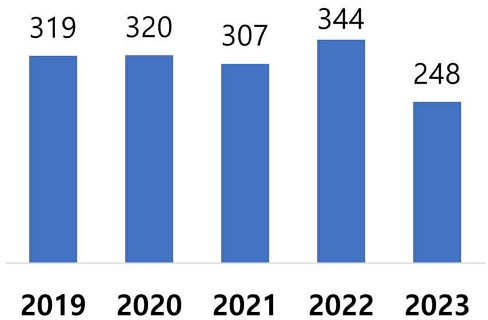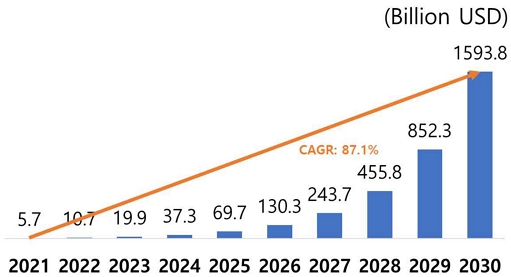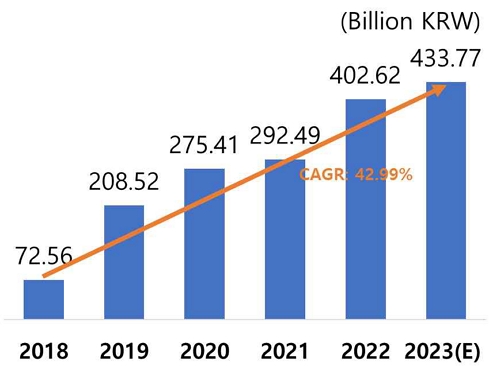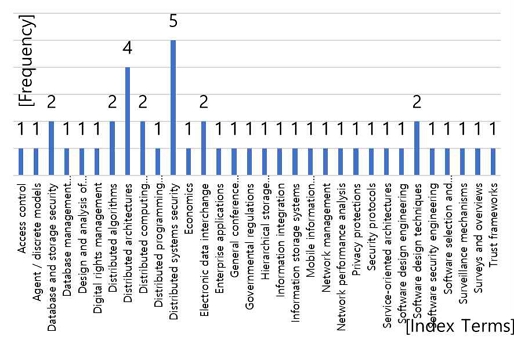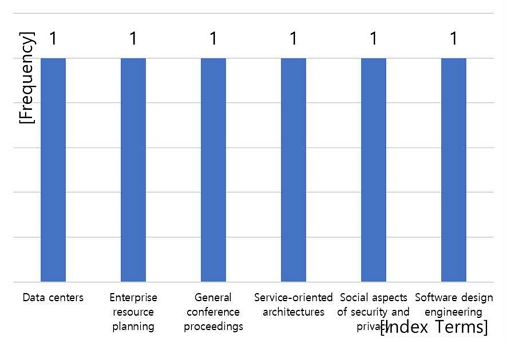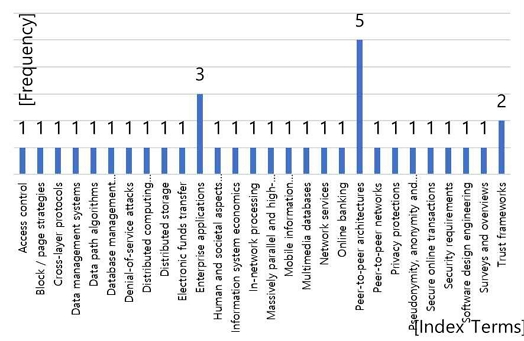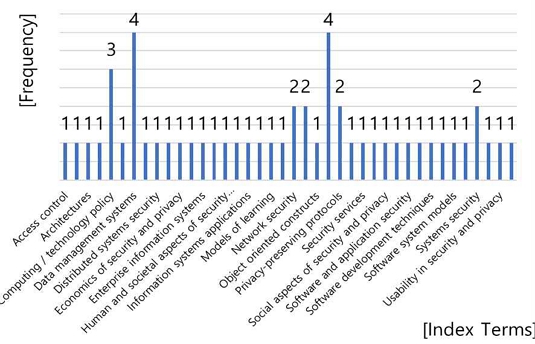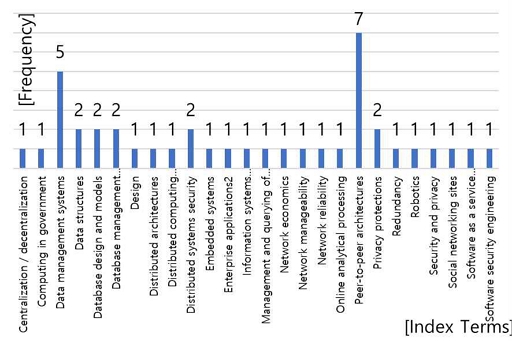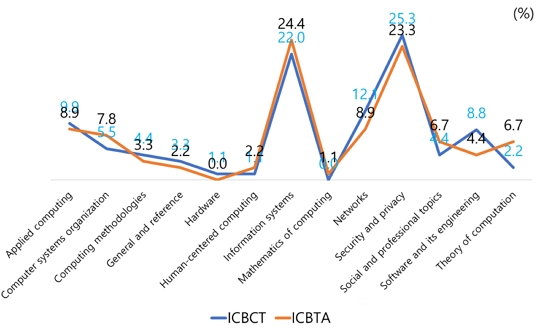
해외 연구 동향을 고려한 블록체인 기술의 분류에 관한 연구
Copyright ⓒ 2024 The Digital Contents Society
This is an Open Access article distributed under the terms of the Creative Commons Attribution Non-CommercialLicense(http://creativecommons.org/licenses/by-nc/3.0/) which permits unrestricted non-commercial use, distribution, and reproduction in any medium, provided the original work is properly cited.

초록
블록체인 기술은 국내를 비롯한 해외에서도 상당 수준 연구되고 있고, 산업에서도 기술의 요소별로 분류되어 관리되고 있다. 그에 따른 연구 동향을 비롯한 다수의 연구 사례가 확인되지만, 체계적인 컴퓨팅 기술 분류 체계를 바탕으로 분석된 사례는 확인되지 않는다. 이에 본 연구에서는 ACM의 컴퓨팅 분류 체계(CCS)를 바탕으로 블록체인 콘퍼런스인 ICBCT와 ICBTA 콘퍼런스에서 최근 5개년간 발표된 논문에 나타난 색인어를 분석하였다. 색인어 분석을 통해 ICBCT와 ICBTA 콘퍼런스에서 나타난 최신 연구 동향을 파악하였으며, 두 콘퍼런스에서 나타난 색인어를 비교한 결과, 개최 목적과 주제는 상이하지만, 주요 요소기술의 비중이 유사하다는 결론을 도출하였다. 본 연구를 통해 산출한 연구 결과는 블록체인 기술의 연구 및 개발, 정책 기획 등의 참고자료로 활용될 수 있을 것으로 기대한다.
Abstract
Blockchain technology has been extensively studied both domestically and internationally, with its various components systematically categorized and managed within the industry. Although several trends and case studies have been reported, analysis based on a systematic computing classification system is lacking. This study focuses on analyzing the index terms in papers presented at the ICBCT and ICBTA conferences over the past five years, based on the ACM computing classification system. By examining these index terms, we identified recent research trends presented at these conferences and compared the index terms used. Irrespective of the differing purposes and topics between the two conferences, there was a notable similarity in the proportion of key technologies discussed. The findings from this study are expected to serve as valuable reference materialsfor blockchain technology research and development, as well as for policy planning and related areas.
Keywords:
Technology Classification, Technology Classification System, Blockchain, Blockchain Applications, ACM CCS키워드:
기술 분류, 기술 분류 체계, 블록체인, 블록체인 응용Ⅰ. 서 론
블록체인은 2008년 Satoshi Nakamoto에 의해 제안된 분산 원장 관리 기술로[1], 전자거래를 비롯한 뱅킹, 헬스케어, 신원 관리 등의 분야에서 연구 및 개발되고 있으며, 비트코인, 이더리움, 리플 등 암호화폐 운영의 핵심기술이다. 블록체인은 암호화폐를 운영하기 위한 핵심기술이지만, 블록체인을 통해서 구현될 수 있는 스마트 컨트랙트, 탈중앙화된 네트워크의 운영, 생활에 적용될 수 있는 응용, 기계 지능과 자료 분석 기능을 포함한 실생활을 위한 응용 분야 등 기술의 확장 가능성은 상당 수준 향상되었다. 이에 블록체인 응용기술의 주요 기능 변화에 따라서 블록체인 1.0 ~ 블록체인 5.0 기술로 분류한다(표 1). Satoshi Nakamoto가 제안한 암호화폐 운영 기술을 블록체인 1.0으로 정의하고, 스마트 컨트랙트 기능이 구현된 기술을 블록체인 2.0, 투명성을 보장하기 위해 탈중앙화된 네트워크에서 운영하기 위한 기술을 블록체인 3.0으로 분류하며, 생활에 적용 가능한 기술을 블록체인 4.0, 스마트 애플리케이션의 자동화를 위해 기계 지능과 자료 분석 기능을 포함한 기술을 블록체인 5.0으로 분류한다[2].
Choi 외 1인의 연구 결과에 따르면[2], 세계적으로 블록체인 1.0에서부터 블록체인 5.0까지 광범위한 영역에서 연구되고 있으나, 아직까지는 블록체인 5.0에 대한 연구보다는 블록체인 3.0과 블록체인 4.0에 대한 연구가 대부분이다. 블록체인 기술의 발달 과정을 고려할 시, 블록체인은 암호화폐의 구현을 위해서 개발되었으나, 고도화된 기능이 추가되면서 점차 인간 생활을 윤택하게 하는 기술로 발전하고 있다.
블록체인 기술의 특징은 탈중앙화(decentralized), 투명성(transparency), 중복성(redundancy), 불변성 (immutability)으로 요약되고, 장점은 보안성(security), 분산성(distributed), 효율성(efficiency), 투명성(transparency), 안정성(resilience), 신뢰성(trust)으로 요약되며, 단점은 데이터와 연산의 중복으로 인한 자원의 낭비(wasteful), 중앙 집중형 시스템과 비교했을 때 추가로 발생하는 네트워크 속도 및 비용(network speed and cost), 지속적으로 증가하는 블록의 크기(block size), 중앙 집중된 시스템 대비 낮은 성능(performance), 표준의 부재(standards)로 요약된다[3]. 블록체인 기술의 장점을 활용하고, 단점을 개선하기 위한 국내를 비롯한 세계적으로 수많은 연구 사례가 확인되며, 공학, 사회과학, 복합학, 자연과학, 인문학, 예술체육학, 농수해양학으로 그 분야가 확장되고 있다[4].
한편, 세계적으로 저명한 해외 저널에는 매년 상당 수준의 연구 결과가 수록되고 있고, 매년 개최되는 콘퍼런스에서도 블록체인을 응용한 신기술이 공개되고 있으며[5], 국내에서도 매년 300여 건의 연구 결과가 전문학술지에 발표되고 있다(그림 1)[6].
블록체인에 대한 초기 관심사는 주로 가상화폐의 유통과 그에 관련된 기술에 집중되어 있었으나, 2023년부터는 가상화폐의 유통 관련 기술인 크립토와 블록체인 기술은 분리되는 추세에 있다[7].
한편, 블록체인 기술에 대한 연구와 개발이 활발하게 이루어지고 있고, 그에 따른 다수의 연구 결과물을 분석하고 요약하기 위한 연구가 진행되고 있으며[3],[8],[9], 더불어 주요 응용 분야인 가상화폐를 평가하기 위한 연구도 진행되고 있어[10], 기술 분류 및 산업 분류를 바탕으로 한 블록체인 기술의 연구 방향에 대한 자료는 충분히 확보된 상태로 파악된다.
그러나 아직까지 블록체인 기술의 연구 동향은 요소기술에 대한 분석보다는 연구 방법에 따라서 구분하거나 응용 사례를 중심으로 분석하는 등, 객관적인 정보를 제공할 수 있는 컴퓨팅 기술을 바탕으로 체계적으로 분석한 사례는 확인되지 않는다. 이에 본 연구에서는 블록체인 관련 최근 연구 동향을 바탕으로 블록체인을 구성하는 요소기술을 학술적으로 분석하고, 향후 블록체인의 연구 및 개발, 정책 추진 등에 활용할 수 있는 기술의 분류를 도출하고자 한다. 이를 위해서 현존하는 컴퓨팅 기술의 분류 체계를 살펴보고, 컴퓨팅 기술을 분류하기에 적합한 분류 체계인 ACM CCS (ACM computing classification systems)를 선정하였다[11].
다음으로 ACM CCS를 활용하여 논문에 대한 요약 정보를 확보할 수 있는 ICBCT (proceedings of the international conference on blockchain technology)와 ICBTA (international conference on blockchain technology and application) 콘퍼런스에 발표된 연구문헌 189건을 분석하였다[12],[13]. 분석에는 각 논문과 ACM digital library에서 제공하는 색인어 (index terms)를 사용하였으며, 이를 통해서 분석기간 내 블록체인 기술의 객관적 분류체계에 의한 연구 동향을 도출하였다. 다음으로 각 블록체인 콘퍼런스에서 다루는 요소기술을 비교하고 분석하였다. 마지막으로 확보한 결과물을 바탕으로 블록체인 기술의 연구 동향을 표현하는 그래프와 분석 인사이트를 도출하였다.
상기 연구를 기술하기 위한 본 논문의 구성은 다음과 같다. Ⅱ절에서는 블록체인 산업의 현황 및 분류, 블록체인 기술을 분류하기 위한 ACM CCS에 대해서 살펴본다. Ⅲ절에서는 블록체인 기술을 연구하기 위한 방법에 대해서 정리한다. Ⅳ절에서는 ICBCT와 ICBTA에 발표된 논문 189건에 대한 색인어 빈도수를 분석하고, ICBCT와 ICBTA의 특징과 동향을 비교 분석한다. Ⅴ절에서는 Ⅳ절에서 얻은 결과를 바탕으로 결론을 도출하고, 이를 바탕으로 블록체인 기술의 연구와 개발, 정책 기획에 활용할 수 있는 방안에 대해서 제언한다.
Ⅱ. 배경지식
2-1 블록체인 산업의 규모 및 전망
블록체인 기술은 금융 서비스, 정부/공공분야, 헬스케어, 소매/전자상거래, 자동차, 콘텐츠/엔터테인먼트, 기타 산업에서 활용되고 있으며[14], 점차 활용 분야를 넓혀가고 있다. 그에 따라 세계적으로 블록체인 산업이 성장하고 있고, 그 규모는 2022년 107억 달러(약 14조 3,091억 원)를 형성하였으며, 연평균 성장률 87.1%를 기록하며 성장해 2030년 1조 5,938억 달러 규모에 달할 것으로 추정된다(그림 2)[15].
국내 블록체인 산업은 2018년 720.56억 원 규모에서 연평균 42.99% 성장하여 2023년 4,337.7억 원 규모를 형성한 것으로 추정된다(그림 3)[16]. 2023년 한국은행에서 공개한 기업경영분석 자료에서 국내 산업 전체의 매출액 증가율이 2020년 –1.05%, 2021년 17.02%, 2022년 15.07%이고, 3개년 평균이 10.35%인 점을 감안할 시 블록체인 산업의 성장률은 국내 전체 산업의 3개년 매출액 증가율 대비 400% 수준으로 급격히 성장하고 있다[17].
국내 블록체인 산업의 분류는 한국소프트웨어정책연구소(SPRi)와 통계청이 분류한 체계가 활용된다. 2018년 한국소프트웨어정책연구소에서 발표한 자료에 따르면 블록체인 소프트웨어 사업은 소프트웨어, 서비스, 하드웨어, 네트워크/보안 중분류로 분류된다(표 2)[18]. 소프트웨어 중분류는 블록체인 플랫폼과 블록체인 애플리케이션(AI, IoT, Cloud 등 접목)으로 분류된다. 서비스 중분류는 IT 서비스와 비즈니스 서비스(암호화폐 포함)로 분류되고, 하드웨어 중분류는 서버와 스토리지로, 네트워크/보안 중분류는 블록체인 보안으로 분류된다.
2018년 통계청에서는 표준산업분류(KSIC)상 10개 세분류로 분류하는 산업분류를 고시하였다(통계청 고시 제2018-269호)[19]. 해당 고시에 따르면, 소프트웨어 개발 및 공급업(J582), 컴퓨터 프로그래밍, 시스템 통합 관리업(J62), 정보서비스업(J63) 3개 중분류, 10개 세분류에 블록체인 관련 업종이 추가되었다(표 3).

Classification for the blockchain industry in the Korean standard industrial classification (KSIC) (J582, J62, J63)
소프트웨어 개발 및 공급업(J582)으로 분류되는 세분류 산업은 블록체인 기반 유선 온라인 게임 소프트웨어 개발 및 공급업, 블록체인 기반 모바일 게임 소프트웨어 개발 및 공급업, 블록체인 기반 시스템 소프트웨어 개발 및 공급업, 블록체인 기반 응용 소프트웨어 개발 및 공급업 4개이고, 컴퓨터 프로그래밍, 시스템 통합 및 관리업(J62)으로 분류되는 세분류 산업은 블록체인 기반 컴퓨터 프로그래밍 서비스업, 블록체인 기반 컴퓨터 시스템 통합 자문 및 구축 서비스업, 블록체인 기술 관련 기타 정보기술 및 컴퓨터 운영 서비스업 3개이며, 정보서비스업(J63)으로 분류되는 세분류 산업은 블록체인 기술 관련 호스팅 서비스업, 블록체인 기반 암호화 자산 매매 및 중개업, 블록체인 기술 관련 기타 정보서비스업 3개이다.
앞서 살펴본 한국소프트웨어정책연구소와 통계청의 블록체인 산업 분류는 블록체인을 응용하는 전체 산업을 포괄하여 분류하는 기준으로, 실제 연구되고 있는 기술을 표현하기에는 다소 무리가 있다. 따라서 연구 및 개발 계획을 수립하거나 정책을 기획하는 데 있어 세부적인 기술의 흐름과 구성에 대한 이해보다는 포괄적인 기술의 분류 및 산업의 분류, 특징에 의존할 수밖에 없다.
2-4 ACM CCS
ACM CCS는 ACM에 의해 개발된 컴퓨팅 분류 체계로, 1964년 처음 제안되어 1982년, 1983년, 1987년, 1991년, 1998년, 2012년, 총 6회에 걸쳐 개정되었으며 현재까지 사용되고 있다[13]. 컴퓨팅 기술의 분류체계는 영국의 Open University에서 제안한 computer science ontology와도 비교되는 분류 체계이며[20], ACM digital library뿐만 아니라 세계의 수학, 물리학, 천문학, 전산 과학, 계량 생물학, 통계학 분야의 출판 전 논문을 수집하는 웹사이트인 ArXiv의 기술 분류 체계로 활용되고 있다[21]. ACM CCS는 총 6개 계층 구조를 가지며, 최상위 계층인 1계층은 13개 카테고리로 구성되며(그림 4), 총 2,113개 키워드로 구성된다.
ACM digital library에 게시되는 논문은 문헌 자체에서 색인어 (index terms)가 제공되거나 ACM 홈페이지의 서지 정보에서 제공된다. 또한, 논문에서 제공되는 CCS와 ACM 홈페이지에서 제공되는 CCS가 상이한 경우도 있으며, 논문의 색인어와 keywords가 분리되어 있어, 별도로 기술된다. keywords는 논문 저자가 임의로 선정하여 제공하는 반면, 색인어는 논문의 저자가 CCS 내에서 논문과 매치되는 키워드를 선정하여 기술한다.
Ⅲ. 연구 방법
3-1 연구방법 개요 및 목적
본 연구는 ACM 홈페이지에서 제공하는 서지정보와 논문으로부터 데이터를 확보하고, 이를 분석에 적합하도록 전처리하고 집계하여 빈도수를 분석한다. 이를 위해서 ACM digital library에서 출판물이 확인되는 블록체인 관련 콘퍼런스를 선정하였고, 해당 콘퍼런스에 발표된 논문 189건에 대해 색인어를 바탕으로 빈도수를 분석하였다. 이때 각 논문의 색인어는 ACM에서 제공하는 ACM CCS와 1:1로 매핑된다. 이 점에 착안하여 ACM digital library에 소개된 최근 논문의 트렌드를 비교 및 분석하는 한편, 1레벨에서부터 6레벨로 구성된 ACM CCS 분류체계에서 블록체인과 관련된 색인어만을 별도로 표현하여 시각화한다(그림 5). 이를 통해서 최근 연구 동향이 반영된 블록체인 기술의 구성요소를 제공하는 것을 목적으로 한다.
3-2 연구 대상
ACM digital library에 소개된 블록체인 관련 논문은 다수의 저널과 콘퍼런스를 통해 출판됐다. 콘퍼런스의 경우 동일 주제를 목표로 출판된 출판물이므로 블록체인 및 그 응용에 관련된 분석이 용이하고, 저널 논문의 경우 연구 결과물이 산발적으로 분포해 있고, 주제 또는 세션별로 정리되어 있지 않아 분석이 어렵다. 이에 본 연구에서는 콘퍼런스를 중심으로 선정하였다.
ACM digital library에서 검색되는 블록체인 관련 콘퍼런스를 검토한 결과 ICBCT와 ICBTA가 확인된다. ICBCT는 2019년 미국 호놀룰루에서 최초 개최되었고, 2023년 중국 구이린에서 제5회 콘퍼런스가 개최되었으며, 매년 3월 ~ 5월 사이에 개최된다. ACM digital library에서는 ICBCT'19 ~ ICBCT'22의 출판물 99개를 다운로드할 수 있다. ICBTA는 2018년 중국 시안에서 최초 개최되었고, 2023년까지 지속해서 중국 시안에서 개최되었으며, 매년 11~12월에 개최된다. ACM digital library에서는 ICBTA'18 ~ ICBTA'22의 출판물 90개를 다운로드할 수 있다. ICBCT는 주로 블록체인의 기술에 대한 연구 문헌이 주를 이루고, ICBTA는 블록체인 기술과 그 응용 방법에 대한 연구 문헌이 다수 확인된다.
Ⅳ. 결과 분석
4-1 ICBCT 콘퍼런스의 연도별 세션 및 색인어 분석
표 4는 ICBCT'19의 세션과 세션을 구성하는 논문의 색인어를 중복을 제거하여 표현한 것이다. blockchain fundamentals, blockchain for finance, blockchain for medicine and health care 세션으로 구성되어 있어, 블록체인 기술에 대한 원천기술과 금융, 의약학을 주제로 세션이 구성되었다. 각 세션은 7, 5, 2개의 논문으로 구성되어 있고, 전체 24개의 색인어로 구성되어 있으며, 중복을 제거할 시 22개의 색인어로 구성된다.
표 5는 ICBCT'20의 세션과 세션을 구성하는 논문의 색인어를 중복을 제거하여 표현한 것이다. blockchain fundamentals, blockchain for internet of things, blockchain for finance, blockchain for public service, blockchain technology 세션으로 구성되어 있어, 블록체인 원천기술과 IoT, 금융, 공공서비스를 주제로 세션이 구성되어 있다. 각 세션은 8, 5, 5, 8, 4개의 논문으로 구성되어 있고, 44개의 색인어로 구성되어 있으며, 중복을 제거할 시 32개의 색인어로 구성된다.
표 6은 ICBCT'21의 세션과 세션을 구성하는 논문의 색인어를 중복을 제거하여 표현한 것이다. blockchain and digital economy, blockchain and information security, blockchain and internet of things technology, blockchain theory and key technologies, data security and privacy protection 세션으로 구성되어 있어, 블록체인 생태계, IoT, 핵심기술, 데이터 보안 및 개인정보 보호 등의 주제로 구성되어 있다. 각 세션은 6, 5, 7, 7, 5개의 논문으로 구성되어 있고, 73개의 색인어로 구성되어 있으며, 중복을 제거할 시 46개의 색인어로 구성된다.
표 7은 ICBCT'22의 세션과 세션을 구성하는 논문의 색인어를 중복을 제거하여 표현한 것이다. models and technologies of blockchain in economic management, management and application of blockchain in digital currency, structural framework and model of blockchain in information management, blockchain information authentication and security 세션으로 구성되어 있어, 블록체인 생태계, 디지털 화폐, 구조적 개선 등의 주제로 구성되어 있다. 각 세션은 4, 6, 9, 6개의 논문으로 구성되어 있고, 31개의 색인어로 구성되어 있으며, 중복을 제거할 시 26개의 색인어로 구성된다.
4-2 ICBTA 콘퍼런스의 연도별 세션 및 색인어 분석
표 8은 ICBTA'18의 세션과 세션을 구성하는 논문의 색인어를 중복을 제거하여 표현한 것이다. blockchain technology and intelligent applications 세션으로 구성되어 있어, 블록체인 애플리케이션을 주제로 세션이 구성되었다. 해당 세션은 5개의 논문으로 구성되어 있고, 6개의 색인어로 구성되어 있다.
표 9는 ICBTA'19의 세션과 세션을 구성하는 논문의 색인어를 중복을 제거하여 표현한 것이다. blockchain technology and data security, advanced blockchain technology and application 세션으로 구성되어 있어, 블록체인 애플리케이션과 데이터 보안을 주제로 세션이 구성되었다. 각 세션은 9, 13개의 논문으로 구성되어 있고, 전체 35개의 색인어로 구성되어 있으며, 중복을 제거할 시 28개 색인어로 구성된다.
표 10은 ICBTA'20의 세션과 세션을 구성하는 논문의 색인어를 중복을 제거하여 표현한 것이다. blockchain technology and information security, advanced blockchain and application technology 세션으로 구성되어 있어, 블록체인 애플리케이션과 정보보안을 주제로 세션이 구성되었다. 각 세션은 7, 6개의 논문으로 구성되어 있고, 전체 19개의 색인어로 구성되어 있으며, 중복을 제거할 시 18개 색인어로 구성된다.
표 11은 ICBTA'21의 세션과 세션을 구성하는 논문의 색인어를 중복을 제거하여 표현한 것이다. blockchain and information security, blockchain and digital economy, blockchain theory and application, advanced information technology and blockchain 세션으로 구성되어 있어, 블록체인 강화된 애플리케이션과 정보보안을 주제로 세션이 구성되었다. 각 세션은 6, 7, 6, 6개의 논문으로 구성되어 있고, 전체 52개의 색인어로 구성되어 있으며, 중복을 제거할 시 40개 색인어로 구성된다.
표 12는 ICBTA'22의 세션과 세션을 구성하는 논문의 색인어를 중복을 제거하여 표현한 것이다. models and technologies of blockchain in economic management, management and application of blockchain in digital currency, structural framework and model of blockchain in information management, blockchain information authentication and security 세션으로 구성되어 있어, 블록체인 애플리케이션과 디지털화폐, 정보 관리 측면에서의 구조적 프레임워크, 정보 인증과 보안을 주제로 세션이 구성되었다. 각 세션은 4, 6, 9, 6개의 논문으로 구성되어 있고, 전체 31개의 색인어로 구성되어 있으며, 중복을 제거할 시 26개 색인어로 구성된다.
4-3 ICBCT 콘퍼런스에서 나타난 색인어 빈도수 분석 결과
4-3에서는 ICBCT 콘퍼런스에 발표된 색인어에 대한 빈도수 분석을 통해서 연도별, 콘퍼런스별 특징을 분석하였다. ICBCT'19에는 14개의 논문이 발표되었고, 이에 대한 빈도수 분석 결과를 표 13에 나열하였다. 14개의 논문은 총 24개의 색인어와 연결되어 있고, database management system engines를 제외한 나머지 21개 색인어의 빈도수는 1이다(그림 6). 14개의 논문에서 나타난 색인어 중 빈도수가 높은 database management system engines 색인어를 포함하는 3건의 논문을 검토한 결과, 해당 논문에서는 블록체인 기반 프레임워크의 제안[22], 블록체인 응용 프로그램의 시뮬레이션[23], 디지털 통화 및 정책에 대해서 기술하고 있다[24]. 이를 고려할 시 해당 색인어는 블록체인을 이용한 데이터 관리에 초점을 맞추고 있는 것으로 판단된다.
ICBCT'20에서 발표된 30개 논문을 분석한 결과, 빈도수가 2 이상인 색인어는 distributed systems security, distributed architectures 등 7개 색인어가 확인되며, 나머지 25개 색인어의 빈도수는 1이다(표 14, 그림 7).
ICBCT’20에서 발표된 30건의 논문에서 나타난 색인어 중 빈도수가 높은 distributed systems security와 distributed architectures 색인어를 포함하는 6건의 논문을 검토한 결과, 3건의 논문에서 두 개의 색인어가 동시에 나타났고[26]-[28], distributed systems security 색인어가 포함된 5건의 논문을 검토한 결과, 블록체인 및 스마트 컨트랙트를 이용한 데이터 마켓플레이스[25], 암호화폐 주소 분석 툴[26], WEE (waste electrical & electronic equipment) 저감을 위한 블록체인 기반 솔루션[27], 블록체인 기반의 SMPC (secure multi-party computation) 솔루션[28], 블록체인 기반의 신뢰 서비스에 대한 분석[29]에 대해서 기술하고 있으며, distributed architectures 색인어를 포함하는 논문에서는 블록체인 기반의 토지 등록 시스템에 대한 PoC에 대해서 기술하고 있다[30]. 이를 고려할 시 해당 색인어는 블록체인 시스템의 탈중앙화 특성이 고려된 것으로 판단된다.
ICBCT'21의 30개 논문을 분석한 결과, 빈도수가 2 이상인 색인어는 security and privacy, data management systems 등 15개 색인어가 확인되며, 나머지 31개 색인어의 빈도수는 1이다(표 15, 그림 8).
ICBCT’21에서 발표된 30개의 논문에서 나타난 색인어 중 빈도수가 높은 security and privacy 색인어가 포함된 논문을 검토한 결과, 블록체인 기반의 이중 지출 제거 솔루션[31], 컨소시엄 체인 기반의 트랜잭션 관리 시스템[32], 공급망 가시성을 제공하기 위한 분산 원장[33], 하이퍼레저 패브릭 기반의 자원 공유 시스템[34], 차량 추적 및 교통 거래 정보를 제공하는 익명의 주차 관리 시스템에 대해서 기술하고 있다[35]. 이를 고려할 시 해당 색인어는 블록체인의 익명성과 신뢰성에 기반한 시스템 또는 기술이 고려된 것으로 판단된다.
ICBCT'22의 25개 논문을 분석한 결과, 빈도수가 2 이상인 색인어는 distributed systems security, enterprise applications, computer games이고, 나머지 23개 색인어의 빈도수는 1이다(표 16, 그림 9).
ICBCT'22에서 발표된 25건의 논문에서 나타난 색인어 중 빈도수가 높은 distributed systems security 색인어를 포함하는 논문을 검토한 결과, 블록체인의 확장성 개선을 위한 샤딩 기술의 보안 분석[36], 블록체인 기술에 대한 정의, 설계 원칙, 구성 요소에 대한 분석[37], 컨소시엄 블록체인과 프록시 재암호화를 결합한 데이터 공유 솔루션[38], 차량 간 네트워크를 위한 계층적 데이터 공유 및 관리 시스템[39]에 대해서 다루고 있는 논문에서 해당 색인어를 포함하고 있다. 이를 고려할 시 해당 색인어는 블록체인의 탈중앙화 특성과 블록체인의 보안성이 고려된 것으로 판단된다.
ICBCT'19에서부터 ICBCT'22년까지 99개 논문은 분석한 결과 총 172개의 색인어가 확인되었고, 91개 색인어와 연결되었다. 주요 색인어는 주로 탈중앙화와 관련된 색인어로, distributed systems security, distributed architectures, distributed computing methodologies, distributed algorithms, database and storage security의 색인어가 확인된다. 즉, ICBCT는 탈중앙화와 관련된 색인어의 빈도수가 높은 것으로 파악된다(표 17). 특히 distributed systems security와 distributed architectures 색인어의 빈도수가 높은 점은 ICBCT에서 블록체인의 탈중앙화 특성, 익명성과 신뢰성에 중심을 둔 기술이 다수 발표되었기 때문으로 판단된다.
4-4 ICBTA 콘퍼런스에서 나타난 색인어 빈도수 분석 결과
4-4에서는 ICBTA 콘퍼런스에 발표된 색인어에 대한 빈도수 분석을 통해서 연도별, 콘퍼런스별 특징을 분석하였다. ICBTA'18에는 5개의 논문이 발표되었고, 이에 대한 빈도수 분석 결과를 표 18에 나열하였다(그림 10).
ICBTA'19의 22개 논문을 분석한 결과, 빈도수가 2 이상인 색인어는 peer-to-peer architectures, enterprise applications, trust frameworks으로 확인되며, 나머지 28개의 색인어의 빈도수는 1이다(표 19, 그림 11).
ICBTA'19에서 발표된 22개 논문에서 나타난 색인어 중 빈도수가 높은 peer-to-peer architectures 색인어를 포함하는 논문을 검토한 결과, 블록체인의 블록 스페이스에 대한 부분적 예약 알고리즘[40], 경량화된 블록체인의 제안[41], 금융 마켓의 부분적인 메커니즘을 블록체인으로 전환하기 위한 솔루션[42], 블록체인 기반의 공원 청소 관리 솔루션[43], 집단 투표 시스템의 프로토타입에 대해 기술하고 있다[44]. 블록체인 기술은 P2P (peer to peer) 기술을 근간으로 하고 있고, 블록 스페이스 예약 알고리즘, 블록체인 기반의 금융 솔루션, 블록체인 기반의 공원 청소 관리 솔루션 등 블록체인 응용 솔루션 또는 서비스는 P2P architecture의 설계에 따라서 서비스 품질(효율성, 지연시간 등)이 결정되는 요소이고, 이를 고려할 시 해당 색인어는 이와 같은 블록체인 응용 서비스의 특징이 고려된 것으로 판단된다.
ICBTA'20의 13개 논문을 분석한 결과, 빈도수가 2 이상인 색인어는 peer-to-peer architectures로 확인되고, 나머지 17개 색인어의 빈도수는 1이다(표 20, 그림 12).
ICBTA'20에서 발표된 13개 논문에서 나타난 색인어 중 빈도수가 높은 peer-to-peer architectures를 포함하는 논문을 검토한 결과, 다중 블록체인을 위한 master&slave 체인 모델[45], 마이너의 컴퓨팅 효율성을 측정하기 위한 miner efficiency numerical model과 효율성 개선을 위한 dynamic difficulty calculation and tuning에 대해서 기술하고 있다[46]. 이를 고려할 시 해당 색인어는 블록체인 기반의 (응용) 시스템의 효율성을 개선하기 위한 핵심 요소와 관련이 있는 것으로 판단된다.
ICBTA'21의 25개 논문을 분석한 결과, 빈도수가 2 이상인 색인어는 peer-to-peer architectures, data management systems, computing / technology policy, network security, networks, privacy-preserving protocols, systems security로 확인되고, 나머지 33개 색인어의 빈도수는 1이다(표 21, 그림 13).
ICBTA'21에서 발표된 25개 논문에서 나타난 색인어 중 빈도수가 높은 peer-to-peer architectures, data management systems를 포함하는 논문을 검토한 결과, 3건의 논문에서 peer-to-peer architectures 색인어와 data management systems 색인어가 동시에 포함되어 있다[47]-[49]. 해당 문헌에서는 alliance 체인 관리 시스템[47], 상용 블록체인 기반의 금융 자산의 토큰화 알고리즘[48], 블록체인 기반의 COVID-19 백신 접종 정보 관리 시스템에 대해서 기술하고 있다[49]. 그 외 peer-to-peer architectures 색인어를 포함하는 논문은 여러 기관이 전산으로 포트폴리오를 생성하고 관리하며 공유할 수 있는 프레임워크를 제안하였고[50], data management systems를 포함하는 논문은 EOS.IO 블록체인이 자원을 관리하는 모델을 제안하였다[51]. 이를 고려할 시 앞서 ICBTA'19에서 기술한 바와 같이 블록체인 (응용) 시스템 또는 알고리즘의 개발과 구현에 있어서 P2P architectures가 중요한 요소로 판단된다.
ICBTA'22의 25개 논문을 분석한 결과, 빈도수가 2 이상인 색인어는 peer-to-peer architectures, data management systems, database management system engines, distributed systems security, privacy protections, data structures, database design and models로 확인되고, 나머지 19개 색인어의 빈도수는 1이다(표 22, 그림 14).
ICBTA'22에서 발표된 25개 논문에서 나타난 색인어 중 빈도수가 높은 peer-to-peer architectures, data management systems를 포함하는 논문을 검토한 결과, data management systems 색인어가 포함된 5건의 논문은 peer-to-peer architectures도 포함하고 있다[52]-[56]. 해당 논문에서는 Ethereum 기반의 자산 대출 및 대여 서비스[52], 탈중앙화 거래소 서비스[53], 블록체인 기반의 꿀벌 공급망 관리 서비스[54], 블록체인 기반의 가용성 테스트 솔루션[55], 블록체인과 연동된 팁 서비스에 대해서 기술하고 있다[56]. 그 외 peer-to-peer architectures 색인어를 포함하는 논문은 병렬 스마트 컨트랙트 아키텍처[57], 인도네시아의 의료 데이터를 통합하기 위한 블록체인 기반의 프레임워크의 제안에 대해서 기술하고 있다[58]. 이를 고려할 시 ICBTA'22에서 발표된 문헌에서 나타난 peer-to-peer architectures, data management systems 색인어는 각 논문에서 제안하는 블록체인 기반의 시스템, 애플리케이션, 연동 서비스 등을 설명하기 위해 선정된 것으로 판단된다.
최근 5개년간 개최된 ICBTA의 빈도수 분석 결과 peer-to-peer architectures, data management systems, software design engineering, trust frameworks, computing / technology policy, database management system engines 색인어의 빈도수가 높은 것으로 파악된다(표 23).
ICBTA에서는 블록체인 원천기술보다는 블록체인 응용(서비스)에 대한 문헌이 다수 확인되고, 주요 색인어로 peer-to-peer architectures와 data management systems가 확인되는 점을 고려할 시, 블록체인의 응용에서는 P2P 아키텍처와 데이터 관리가 핵심 요소인 것으로 판단된다.
4-3 ICBCT와 ICBTA 콘퍼런스의 특징 분석
ICBCT와 ICBTA의 결과를 병합하여 빈도수를 분석한 결과를 빈도수가 3 이상인 경우만 표 24에 나열하였다.
ICBCT와 ICBTA 콘퍼런스에서 발표된 논문에 대하여 색인어 빈도수 분석 결과, ICBTA 콘퍼런스의 경우에는 총 91개의 색인어와 연결되었고, 이 중 레벨1의 색인어 2, 레벨2의 색인어 13, 레벨3의 색인어 46, 레벨4의 색인어 24, 레벨5의 색인어 6개로 확인되었고, ICBCT 콘퍼런스의 경우에는 총 91개의 색인어와 연결되었고, 레벨1의 색인어 4, 레벨2의 색인어 17, 레벨3의 색인어 43, 레벨4의 색인어 19, 레벨5의 색인어 8개로 확인되었다. ICBCT 콘퍼런스의 경우에는 분산 시스템의 보안, 구조, 컴퓨팅, 알고리즘 등의 색인어의 빈도수가 높았고, ICBTA의 경우에는 P2P, 소프트웨어 설계, 기업 애플리케이션, 프라이버시 등의 색인어에 대한 빈도수가 높아 다소 다른 성격을 보이는 것으로 파악된다.
ICBCT 콘퍼런스와 ICBTA 콘퍼런스에 나타난 색인어는 색인어의 레벨이 서로 상이하여 직접 비교가 불가능하다. 따라서 각 색인어를 해당 색인어의 최상위 레벨의 색인어로 매핑하여 비교 분석하였다. 예를 들어, distributed systems organizing principles 색인어는 CCS 내에서도 software and its engineering → software organization and properties → software system structures → distributed systems organizing principles에 해당하는 4레벨 키워드이다. 이를 최상위 레벨의 색인어인 software and its engineering으로 매핑하는 방식이다. 즉, 다양한 키워드를 13개로 구성된 ACM CCS 레벨1 키워드로 매핑함으로써 비교 대상을 단순화하고, 이를 통해 ICBCT 콘퍼런스와 ICBTA 콘퍼런스에 나타난 색인어의 동향을 간접적으로 비교하는 방식이다. 이에 대한 결과를 표 25에 나열하였다.
표 25의 결과에 따르면, ICBCT와 ICBTA의 색인어는 CCS 분류상 information systems와 security and privacy의 비중이 20% 이상으로 높아, 다른 색인어 대비 중요도가 높은 것으로 나타났다. 또한, computing methodologies, general and reference, hardware, human-centered computing, mathematics of computing과 연결된 색인어는 없거나 매우 낮은 수준(5% 이하)으로 나타났다.
보다 면밀한 분석을 위해 ICBCT와 ICBTA 콘퍼런스에 나타난 색인어를 1레벨로 매핑했을 때 결과를 그래프를 통해서 비교한 결과, 두 콘퍼런스에서 나타난 1레벨 색인어의 전체적인 경향은 비슷하게 나타났으며, computer systems organization, software and its engineering, theory of computation에서 시각적으로 식별 가능한 수준의 차이가 나타났다(그림 15). 결과적으로 블록체인 기술은 information systems와 security and privacy에 해당하는 요소기술의 비중이 20% 이상으로 나타난 것으로 판단된다.
Ⅴ. 결 론
본 논문에서는 블록체인 기술 동향을 파악하고, 이를 바탕으로 기술의 분류 체계를 개발하기 위하여 세계적인 블록체인 콘퍼런스인 ICBCT와 ICBTA에 나타난 189개 논문을 분석하였다. 2019년 처음 개최되어 2023년까지 개최된 ICBCT 콘퍼런스는 ACM digital library에서 99개 논문을 다운로드할 수 있고, 2018년 처음 개최되어 2023년까지 개최된 ICBTA 콘퍼런스는 90개 논문을 다운로드할 수 있다. 이에 189개 논문에 나타난 색인어를 추출하여 빈도수를 분석한 결과, ICBCT 콘퍼런스에서는 distributed systems security, distributed architectures, distributed computing methodologies, distributed algorithms, database and storage security의 색인어 등 분산 시스템과 관련된 색인어의 빈도수가 높았고, ICBTA 콘퍼런스에서는 peer-to-peer architectures, data management systems, software design engineering, trust frameworks, computing / technology policy, database management system engines 색인어 등 아키텍처와 컴퓨팅 기술, 데이터베이스 관리 등의 빈도수가 높게 나타났다. ICBCT와 ICBTA 콘퍼런스를 통합하여 빈도수를 분석한 결과 database and storage security, distributed systems organizing principles, networks, designing software, block / page strategies, digital cash, information integration, spatial-temporal systems, general conference proceedings, network protocols 등 분산 원장과 네트워크, 디지털 화폐 등의 색인어 빈도수가 높은 것으로 분석되었다.
두 콘퍼런스에서 나타난 색인어는 CCS 내에서 레벨이 상이하여 직접 비교가 불가능하여, 이를 간접 비교하기 위하여 각 색인어를 CCS 최상위 13개 키워드로 매핑하여 분석한 결과 information systems와 security and privacy의 색인어 비중이 높은 것으로 분석되었으며, 그래프를 통해 비교해 본 결과 전반적으로 각 콘퍼런스에서 나타난 색인어의 비중이 유사하게 나타나는 것을 확인하였다. 특히 ICBCT 콘퍼런스와 ICBTA 콘퍼런스는 각각 블록체인의 원천기술과 애플리케이션을 중심으로 세션을 구성하므로, 목적과 성격이 다소 상이하지만, 요소기술 측면에서 유사한 경향이 나타났다. 결과적으로 본 연구를 통해서 획득한 결과물은 블록체인 기술의 연구 및 개발, 정책의 기획에 있어 가용자원을 전략적으로 배치하는 데 참고자료로 활용될 수 있을 것으로 예상된다.
본 논문의 연구 결과물은 블록체인 기술이 다루어지고 있는 최근 연구 동향을 반영하고 있으며, 이를 바탕으로 제시된 블록체인 기술의 분류체계는 향후 블록체인의 연구, 블록체인 관련 정책을 추진함에 있어 활용될 수 있을 것으로 기대한다. 나아가 향후 연구에서는 블록체인 기술을 바탕으로 한 기술의 발전 방향을 분석하는 연구를 수행하고자 한다.
Acknowledgments
이 논문은 2024년도 정부(과학기술정보통신부)의 재원으로 정보통신기획평가원의 지원을 받아 수행된 연구임(RS-2023-00216221, 지능형 재구성 안테나 기반 5G-Advanced 이동통신 서비스 커버리지 확대 기술 개발)
References
- S. Nakamoto. Bitcoin: A Peer-to-Peer Electronic Cash System [Internet]. Available: https://bitcoin.org/bitcoin.pdf, .
-
T.-M. Choi and T. Siqin, “Blockchain in Logistics and Production from Blockchain 1.0 to Blockchain 5.0: An Intra-Inter-Organizational Framework,” Transportation Research Part E: Logistics and Transportation Review, Vol. 160, 102653, April 2022.
[https://doi.org/10.1016/j.tre.2022.102653]

-
S. Namasudra, G. C. Deka, P. Johri, M. Hosseinpour, and A. H. Gandomi, “The Revolution of Blockchain: State-of-the-Art and Research Challenges,” Archives of Computational Methods in Engineering, Vol. 28, No. 3, pp. 1497-1515, May 2021.
[https://doi.org/10.1007/s11831-020-09426-0]

-
H. J. Lee and Y. H. Kim, “A Study on the Blockchain in Business: Research Trends and Issues between Korea and Overseas,” The e-Business Studies, Vol. 22, No. 1, pp. 159-176, February 2021.
[https://doi.org/10.20462/TeBS.2021.2.22.1.159]

- The Daily Hodl. CES 2024 – Exploring Blockchain’s Role in Consumer Technology [Internet]. Available: https://dailyhodl.com/2024/01/30/ces-2024-exploring-blockchains-role-in-consumer-technology/, .
- National Research Foundation of Korea. Korea Citation Index [Internet]. Available: https://www.kci.go.kr/, .
- eToday. Diminished emphasis on ‘Crypto’ at CES... “Separating from Blockchain Technology” [Internet]. Available: https://www.etoday.co.kr/news/view/2320715/, .
-
L. Soltanisehat, R. Alizadeh, H. Hao, and K.-K. R. Choo, “Technical, Temporal, and Spatial Research Challenges and Opportunities in Blockchain-Based Healthcare: A Systematic Literature Review,” IEEE Transactions on Engineering Management, Vol. 70, No. 1, pp. 353-368, January 2023.
[https://doi.org/10.1109/TEM.2020.3013507]

-
G. Habib, S. Sharma, S. Ibrahim, I. Ahmad, S. Qureshi, and M. Ishfaq, “Blockchain Technology: Benefits, Challenges, Applications, and Integration of Blockchain Technology with Cloud Computing,” Future Internet, Vol. 14, No. 11, 341, November 2022.
[https://doi.org/10.3390/fi14110341]

- Korea Society of Blockchain. Blockchain Analysis and Evaluation Criteria Guidelines V2 [Internet]. Available: http://www.ksblockchain.or.kr/home/bbs/board.php?bo_table=sosik&wr_id=14/, .
- ACM Digital Library. ACM Computing Classification System [Internet]. Available: https://dl.acm.org/ccs, .
- ACM Digital Library. ICBCT: International Conference on Blockchain Technology [Internet]. Available: https://dl.acm.org/conference/icbct/, .
- ACM Digital Library. ICBTA: International Conference on Blockchain Technology and Application [Internet]. Available: https://dl.acm.org/conference/icbta/, .
- Ministry of SMEs and Startups and Korea Technology and Information Promotion Agency for SMEs. Technology Roadmap for SME 2021-2023 (Blockchain) [Internet]. Available: https://tb.kibo.or.kr/ktms/board/download.do?rbsIdx=436&idx=39&fidx=1, .
- National IT Industry Promotion Agency. NIPA ICT Global Market Analysis (Blockchain) [Internet]. Available: https://www.globalict.kr/product/product_view.do?menuCode=030200&artclCode=DP0400&catNo=323&viewMode=view&knwldNo=143116, .
- Ministry of Science and ICT. Survey of the Blockchain Industry in 2023 [Internet]. Available: https://www.msit.go.kr/publicinfo/view.do?sCode=user&mId=63&mPid=62&pageIndex=&formMode=R&referKey=693%2C4&publictSeqNo=693&publictListSeqNo=4&searchMapngCd=&searchSeCd=&searchOpt=ALL&searchTxt=%EB%B8%94%EB%A1%9D%EC%B2%B4%EC%9D%B8&pageIndex2=1/, .
- Bank of Korea. Financial Statement Analysis for 2022 [Internet]. Available: https://www.bok.or.kr/portal/bbs/P0000599/view.do?nttId=10080133&menuNo=200455&pageIndex=1/, .
- Software Policy & Research Institute. Blockchain Classification System [Internet]. Available: https://spri.kr/posts/view/22444?code=stat_sw_classify/, .
- Statistics Korea. Classification Notice for Blockchain Technology Industry (Notification No. 2018 - 269 from Statistics Korea) [Internet]. Available: https://kostat.go.kr/board.es?mid=a10403040000&bid=107&act=view&list_no=369087, .
- Computer Science Ontology. CSO - Portal [Internet]. Available: https://cso.kmi.open.ac.uk/home, .
- arXiv. arXiv.org e-Print Archive [Internet]. Available: https://arxiv.org/, .
-
X. Ma, D. Xu, and H. Dang, “BGP-LSChain: An Inter-domain Link State Sharing Framework Based on Blockchain,” in Proceedings of the 2019 International Conference on Blockchain Technology (ICBCT ’19), Honolulu: HI, pp. 19-23, March 2019.
[https://doi.org/10.1145/3320154.3320157]

-
L. Ismail, H. Hameed, M. AlShamsi, M. AlHammadi, and N. AlDhanhani, “Towards a Blockchain Deployment at UAE University: Performance Evaluation and Blockchain Taxonomy,” in Proceedings of the 2019 International Conference on Blockchain Technology (ICBCT ’19), Honolulu: HI, pp. 30-38, March 2019.
[https://doi.org/10.1145/3320154.3320156]

-
M. Sun, Y. Sun, K. Sun, X. Tang, and C. Li, “Analysis of Digital Currency Investment,” in Proceedings of the 2019 International Conference on Blockchain Technology (ICBCT ’19), Honolulu: HI, pp. 45-48, March 2019.
[https://doi.org/10.1145/3320154.3320155]

-
P. Sharma, S. Lawrenz, and A. Rausch, A. “Towards Trustworthy and Independent Data Marketplaces,” in Proceedings of the 2020 2nd International Conference on Blockchain Technology (ICBCT ’20), Hilo: HI, pp. 39-45, March 2020.
[https://doi.org/10.1145/3390566.3391687]

-
R. Werner, S. Lawrenz, and A. Rausch, “Blockchain Analysis Tool of a Cryptocurrency,” in Proceedings of the 2020 2nd International Conference on Blockchain Technology (ICBCT ’20), Hilo: HI, pp. 80-84, March 2020.
[https://doi.org/10.1145/3390566.3391671]

-
S. Lawrenz, V. Stein, L. Jacobs, and A. Rausch, “A Blockchain-Based Deposit System to Reduce WEE,” in Proceedings of the 2020 2nd International Conference on Blockchain Technology (ICBCT ’20), Hilo: HI, pp. 130-134, March 2020.
[https://doi.org/10.1145/3390566.3391686]

-
Y. Yang, L. Wei, J. Wu, and C. Long, “Block-SMPC: A Blockchain-Based Secure Multi-Party Computation for Privacy-Protected Data Sharing,” in Proceedings of the 2020 2nd International Conference on Blockchain Technology (ICBCT ’20), Hilo: HI, pp. 46-51, March 2020.
[https://doi.org/10.1145/3390566.3391664]

-
S. Gerth and L. Heim, “Trust through Digital Technologies: Blockchain in Online Consultancy Services,” in Proceedings of the 2020 2nd International Conference on Blockchain Technology (ICBCT ’20), Hilo: HI, pp. 150-154, March 2020.
[https://doi.org/10.1145/3390566.3391662]

-
S. Pongnumkul, C. Khonnasee, S. Lertpattanasak, and C. Polprasert, “Proof-of-Concept (PoC) of Land Mortgaging Process in Blockchain-based Land Registration System of Thailand,” in Proceedings of the 2020 2nd International Conference on Blockchain Technology (ICBCT ’20), Hilo: HI, pp. 100-104, March 2020.
[https://doi.org/10.1145/3390566.3391669]

-
Y.-Y. Zhang, M.-Y. Huang, and X. Zhang, “Occupation Mechanism for Eliminating Double-spending Attacks on Trusted Transaction Blockchain,” in Proceedings of the 2021 3rd International Conference on Blockchain Technology (ICBCT ’21), Shanghai, China, pp. 14-19, March 2021.
[https://doi.org/10.1145/3460537.3460543]

-
L. Pan, Y. Wu, M. Zhou, F. Yu, Z. Lu, and H. Chen “Blockchain Based Transaction Management System for IC Industry,” in Proceedings of the 2021 3rd International Conference on Blockchain Technology (ICBCT ’21), Shanghai, China, pp. 60-66, March 2021.
[https://doi.org/10.1145/3460537.3460539]

-
R. Zhao, J. Bal, and X. Ma, “Creating Lean and Agile Supply Chains with Blockchain,” in Proceedings of the 2021 3rd International Conference on Blockchain Technology (ICBCT ’21), Shanghai, China, pp. 135-146, March 2021.
[https://doi.org/10.1145/3460537.3460558]

-
S. Liu and Y. Shang, “Secure Resource Sharing on Hyperledger Fabric Based on CP-ABE,” in Proceedings of the 2021 3rd International Conference on Blockchain Technology (ICBCT ’21), Shanghai, China, pp. 203-209, March 2021.
[https://doi.org/10.1145/3460537.3460541]

-
Z. Feng, L. Wei, Y. Yang, J. Wu, and C. Long, “TChain: A Privacy-Preserving Consortium Blockchain for Parking Charge Management,” in Proceedings of the 2021 3rd International Conference on Blockchain Technology (ICBCT ’21), Shanghai, China, pp. 210-216, March 2021.
[https://doi.org/10.1145/3460537.3460546]

-
X. Li, H. Luo, and J. Duan, “Security Analysis of Sharding in Blockchain with PBFT Consensus,” in Proceedings of the 2022 4th International Conference on Blockchain Technology (ICBCT ’22), Shanghai, China, pp. 9-14, March 2022.
[https://doi.org/10.1145/3532640.3532642]

-
W. Zhao, S. Yang, X. Luo, and J. Zhou, “Dos and Don’ts in Blockchain Research and Development,” in Proceedings of the 2022 4th International Conference on Blockchain Technology (ICBCT ’22), Shanghai, China, pp. 37-43, March 2022.
[https://doi.org/10.1145/3532640.3532646]

-
Z. Hu, Y. Yang, J. Wu, and C. Long, “A Secure and Efficient Blockchain-Based Data Sharing Scheme for Location Data,” in Proceedings of the 2022 4th International Conference on Blockchain Technology (ICBCT ’22), Shanghai, China, pp. 110-116, March 2022.
[https://doi.org/10.1145/3532640.3532655]

-
J. Hu, Y. Yang, J. Wu, and C. Long, “A Blockchain-Based Cross-Domain Data Sharing Scheme for VANETs,” in Proceedings of the 2022 4th International Conference on Blockchain Technology (ICBCT ’22), Shanghai, China, pp. 117-125, March 2022.
[https://doi.org/10.1145/3532640.3532656]

-
S. Kruglik, Y. Madhwal, S. Vorobyov, and Y. Yanovich, “Fractional Reservation Based Mempool Processing in Blockchains,” in Proceedings of the 2019 2nd International Conference on Blockchain Technology and Applications (ICBTA ’19), Xi’an, China, pp. 26-30, December 2019.
[https://doi.org/10.1145/3376044.3376050]

-
C.-W. Huang and Y.-C. Chen, “ZeroCalo: A Lightweight Blockchain Based on DHT Network,” in Proceedings of the 2019 2nd International Conference on Blockchain Technology and Applications (ICBTA ’19), Xi’an, China, pp. 38-42, December 2019.
[https://doi.org/10.1145/3376044.3376064]

-
V. Davydov, A. Gazaryan, Y. Madhwal, and Y. Yanovich, “Token Standard for Heterogeneous Assets Digitization into Commodity,” in Proceedings of the 2019 2nd International Conference on Blockchain Technology and Applications (ICBTA ’19), Xi’an, China, pp. 43-47, December 2019.
[https://doi.org/10.1145/3376044.3376053]

-
J. Zeng, J. Zhang, and Y. Liu, “Blockchain Based Smart Park: Cleaning Management,” in Proceedings of the 2019 2nd International Conference on Blockchain Technology and Applications (ICBTA ’19), Xi’an, China, pp. 53-58, December 2019.
[https://doi.org/10.1145/3376044.3376046]

-
A. Kugusheva and Y. Yanovich, “Ring Signature-Based Voting on Blockchain,” in Proceedings of the 2019 2nd International Conference on Blockchain Technology and Applications (ICBTA ’19), Xi’an, China, pp. 70-75, December 2019.
[https://doi.org/10.1145/3376044.3376054]

-
X. Hu, K. Hu, S. Wang, and Q. Tong, “A Master-slave Chain Model for Multiple Blockchains,” in Proceedings of the 2020 3rd International Conference on Blockchain Technology and Applications (ICBTA ’20), Xi’an, China, pp. 12-18, December 2020.
[https://doi.org/10.1145/3446983.3446988]

-
X. Li and Z. Li, “A Performance Measurement and Optimization Mechanism for Blockchain Mining Pool System,” in Proceedings of the 2020 3rd International Conference on Blockchain Technology and Applications (ICBTA ’20), Xi’an, China, pp. 27-33, December 2020.
[https://doi.org/10.1145/3446983.3446991]

-
H. Ling, F. Wu, J. Chang, H. Liu, and X. Wu, “Alliance Chain Management System and Methods for Personal Files Based on Improved Multi-layer PBFT,” in Proceedings of the 2021 4th International Conference on Blockchain Technology and Applications (ICBTA ’21), Xi’an, China, pp. 31-38, December 2021.
[https://doi.org/10.1145/3510487.3510493]

-
Y. Chaleenutthawut, V. Davydov, A. Kuzmin, and Y. Yanovich, “Practical Blockchain-Based Financial Assets Tokenization,” in Proceedings of the 2021 4th International Conference on Blockchain Technology and Applications (ICBTA ’21), Xi’an, China, pp. 51-57, December 2021.
[https://doi.org/10.1145/3510487.3510495]

-
Y. Madhwal, Y. Yanovich, and I. Chumakov, “CoVID-19 Vaccination Certificate Supply Verification Based on Blockchain,” in Proceedings of the 2021 4th International Conference on Blockchain Technology and Applications (ICBTA ’21), Xi’an, China, pp. 88-93, December 2021.
[https://doi.org/10.1145/3510487.3510500]

-
A. Binbusayyyis, “Blockchain-Based Services for Sharing Education Records in Industrial IoT Environment,” in Proceedings of the 2021 4th International Conference on Blockchain Technology and Applications (ICBTA ’21), Xi’an, China, pp. 135-143, December 2021.
[https://doi.org/10.1145/3510487.3510507]

-
A. De Salve, A. Lisi, P. Mori, and L. Ricci, “Measuring EOS.IO DApp Resource Allocation and Costs through a Benchmark Application,” in Proceedings of the 2021 4th International Conference on Blockchain Technology and Applications (ICBTA ’21), Xi’an, China, pp. 24-30, December 2021.
[https://doi.org/10.1145/3510487.3510492]

-
J. A. L. Escamilla and Y. Yanovich, “Data Mining of Compound DeFi Project,” in Proceedings of the 2022 5th International Conference on Blockchain Technology and Applications (ICBTA ’22), Xi’an, China, pp. 16-23, December 2022.
[https://doi.org/10.1145/3581971.3581974]

-
F. Ghazzawi and Y. Yanovich, “Data Mining of Uniswap Decentralized Exchange,” in Proceedings of the 2022 5th International Conference on Blockchain Technology and Applications (ICBTA ’22), Xi’an, China, pp. 24-33, December 2022.
[https://doi.org/10.1145/3581971.3581975]

-
Y. Madhwal, E. Pieber, Y. Yanovich, and T. Yakushkina, “Smart Contract Based Honey Production Supply Chain,” in Proceedings of the 2022 5th International Conference on Blockchain Technology and Applications (ICBTA ’22), Xi’an, China, pp. 70-76, December 2022.
[https://doi.org/10.1145/3581971.3581981]

-
S. Belyaeva, M. Ivanov, A. Korneev, and Y. Yanovich, “AmIOnline: Blockchain-Based Availability Testing Service,” in Proceedings of the 2022 5th International Conference on Blockchain Technology and Applications (ICBTA ’22), Xi’an, China, pp. 122-128, December 2022.
[https://doi.org/10.1145/3581971.3581989]

-
D. Kurbatov, M. Rybnikova, Y. Madhwal, Y. Yanovich, and G. Zotov, “OnlyTips: Blockchain-Driven Tips Service,” in Proceedings of the 2022 5th International Conference on Blockchain Technology and Applications (ICBTA ’22), Xi’an, China, pp. 129-139, December 2022.
[https://doi.org/10.1145/3581971.3581990]

-
T. Xu and Y. Zhang, “A Parallel Execution Model for Permissioned Blockchain Systems,” in Proceedings of the 2022 5th International Conference on Blockchain Technology and Applications (ICBTA ’22), Xi’an, China, pp. 83-87, December 2022.
[https://doi.org/10.1145/3581971.3581983]

-
A. H. Munassar, M. A. Arsyad, and R. Richard, “Improving Healthcare Record Management System in Indonesia by Using Blockchain Technology,” in Proceedings of the 2022 5th International Conference on Blockchain Technology and Applications (ICBTA ’22), Xi’an, China, pp. 117-121, December 2022.
[https://doi.org/10.1145/3581971.3581988]

저자소개

2012년:중앙대학교 전자전기공학부 (공학사)
2014년:중앙대학교 대학원 전자전기공학과 (공학석사)
2023년:중앙대학교 대학원 전자전기공학과 (공학박사)
2016년 12월~2018년 6월: IMS나노텍
2018년 7월~2019년 12월: 중앙대학교 신기능이미징연구소
2024년 1월~현 재: 전자통신연구원
※관심분야:5G/6G 이동통신, Extreme Massive MIMO, Channel Coding

1993년:KAIST 물리학 학사
1995년:충남대학교 대학원 물리학 (이학석사)
1999년:충남대학교 대학원 물리학 (이학박사)
1999년 9월~현 재: ETRI
※관심분야:5G/6G 이동통신, Massive MIMO, RIS

2009년:Colorado State University, Biomedical Sciences (이학사)
2016년:연세대학교 대학원 응용생명과학과 (이학박사)
2016년 9월~2019년 3월: 서울대학교 치학연구소, 선임연구원
2019년 6월~2024년 2월: NICE평가정보 주식회사, 전문연구원
2024년 3월~현 재: MKS특허경영 전문위원
※관심분야:기술가치평가, 데이터가치평가, 가상자산평가

2005년:건국대학교 인터넷미디어공학부 (공학사)
2008년:건국대학교 일반대학원 컴퓨터정보통신공학과 (공학석사-컴퓨터)
2015년:건국대학교 일반대학원 컴퓨터정보통신공학과 (공학박사-컴퓨터)
2022년 7월~현 재: NICE평가정보 주식회사, 전문위원
※관심분야:기술금융, 가상자산, 데이터자산, 시스템 소프트웨어, 무인비행체

2014년:중앙대학교 전자전기공학부 (공학사)
2016년:중앙대학교 대학원 전자전기공학과 (공학석사)
2021년:중앙대학교 대학원 전자전기공학과 (공학박사)
2016년 9월~2020년 8월: 중앙대학교 다빈치교양대학, 강사
2021년 6월~2021년 12월: 중앙대학교 연구처 부설 인문콘텐츠연구소 NIA86 대화체 텍스트 윤리검증 데이터 사업단, 전임연구원(실무책임자)
2022년 2월~2023년 6월: NICE평가정보 주식회사, 전문연구원
2023년 6월~2024년 6월: 코데이터솔루션 주식회사, 과장
2023년 7월~현 재: MKS특허경영, 전문위원
※관심분야:O-RAN, 6G, B6G, Secure Wireless Protocols, PKC-based Authentication Protocols, Blockchain, Elliptic Curve Cryptography, Virtual Assets Valuation, Database Assets Valuation, AI Humanaties, AI Literacy, Computational Thinking
